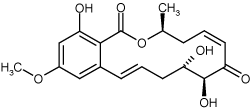Inhibitor of the JNK/p38 pathways. Inhibits anisomycin-induced but not TNF-induced JNK/p38 activation. Potent protein kinase inhibitor.
A naturally isolated cell-permeable fungal resorcylic lactone that acts as a selective and highly potent inhibitor against the MAPKKK TAK1 activity (IC50 = 8nM) in an ATP-competitive and irreversible manner; also inhibits MEK1 (IC50 = 411nM) and three other MAPKKKs (IC50 ≥268 nM against MEKK1, ASK1, and MEKK4) but at much higher concentrations. Shown to inhibit IL-1-induced/TAK1-mediated, but not H2O2-induced/TAK1-independent, JNK and p38 phosphorylation in 293 cells.
Product Details
| Alternative Name: | (5Z)-7-Oxozeaenol |
| |
| Formula: | C19H22O7 |
| |
| MW: | 362.4 |
| |
| Source: | Isolated from Deuteromycetes sp. |
| |
| CAS: | 66018-38-0 |
| |
| Purity: | ≥95% (HPLC) |
| |
| Appearance: | White to off-white solid. |
| |
| Solubility: | Soluble in methanol, acetone, DMSO (up to 25mM) or ethyl acetate; insoluble in ethanol and n-hexane. |
| |
| Shipping: | Ambient Temperature |
| |
| Long Term Storage: | -20°C |
| |
| Regulatory Status: | RUO - Research Use Only |
| |
Please mouse over
Product Literature References
TAK1 inhibition promotes apoptosis in KRAS-dependent colon cancers: A. Singh, et al.; Cell
148, 639 (2012),
Abstract;
In vivo RNAi-mediated silencing of TAK1 decreases inflammatory Th1 and Th17 cells through targeting of myeloid cells: G. Courties, et al.; Blood
116, 3505 (2010),
Abstract;
Targeting innate immunity protein kinase signalling in inflammation: M. Gaestel, et al.; Nat, Rev. Drug Discov.
8, 480 (2009),
Abstract;
Chemistry and biology of resorcylic acid lactones: N. Winssinger & S. Barluenga; Chem. Commun.
1, 22 (2007), (Review),
Abstract;
Full Text
Molecular mechanisms involved in the regulation of cytokine production by muramyl dipeptide: M. Windheim, et al.; Biochem. J.
404, 179 (2007),
Abstract;
Protein kinases as small molecule inhibitor targets in inflammation: M. Gaestel, et al.; Curr. Med. Chem.
14, 2214 (2007), (Review),
Abstract;
Blockade of transforming growth factor-beta-activated kinase 1 activity enhances TRAIL-induced apoptosis through activation of a caspase cascade: M.K. Choo, et al.; Mol. Cancer Ther.
5, 2970 (2006),
Abstract;
Involvement of the extracellular signal-regulated protein kinase pathway in phosphorylation of p53 protein and exerting cytotoxicity in human neuroblastoma cells (SH-SY5Y) exposed to acrylamide: T. Okuno, et al.; Arch. Toxicol.
80, 146 (2006),
Abstract;
JNK (c-Jun NH2 terminal kinase) and p38 during ischemia reperfusion injury in the small intestine: T. Murayama, et al.; Transplantation
81, 1325 (2006),
Abstract;
Transforming growth factor beta-activated kinase 1 is a key mediator of ovine follicle-stimulating hormone beta-subunit expression: N. Safwat, et al.; Endocrinology
14, 4814 (2005),
Abstract;
Suppression of cadmium-induced JNK/p38 activation and HSP70 family gene expression by LL-Z1640-2 in NIH3T3 cells: N. Sugisawa, et al.; Toxicol. Appl. Pharmacol.
196, 206 (2004),
Abstract;
A resorcylic acid lactone, 5Z-7-oxozeaenol, prevents inflammation by inhibiting the catalytic activity of TAK1 MAPK kinase kinase: J. Ninomiya-Tsuji, et al.; J. Biol. Chem.
278, 18485 (2003),
Abstract;
Effects of pentachlorophenol and tetrachlorohydroquinone on mitogen-activated protein kinase pathways in Jurkat T cells: B. Wispriyono, et al.; Environ. Health Perspect.
110, 139 (2002),
Abstract;
Full Text
Pharmacological inhibitors of MAPK pathways: J.M. English & M.H. Cobb; TIPS
23, 40 (2002), (Review),
Abstract;
Cadmium induces phosphorylation of p53 at serine 15 in MCF-7 cells: M. Matsuoka & H. Igisu; BBRC
282, 1120 (2001),
Abstract;
Inhibition of HgCl2-induced mitogen-activated protein kinase activation by LL-Z1640-2 in CCRF-CEM cells: M. Matsuoka, et al.; Eur. J. Pharmacol.
409, 155 (2000),
Abstract;
A radicicol-related macrocyclic nonaketide compound, antibiotic LL-Z1640-2, inhibits the JNK/p38 pathways in signal-specific manner: K. Takehana, et al.; BBRC
257, 19 (1999),
Abstract;












